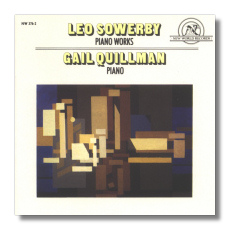
The Internet's Premier Classical Music Source
Related Links
- Sowerby Reviews
- Latest Reviews
- More Reviews
-
By Composer
-
Collections
DVD & Blu-ray
Books
Concert Reviews
Articles/Interviews
Software
Audio
Search Amazon
Recommended Links
Site News
 CD Review
CD Review
Leo Sowerby

Works for Piano
- Sonata for Pianoforte
- Suite for Piano
- Passacaglia
Gail Quillman, piano
New World Records NW376-2 50:15
Summary for the Busy Executive: Big-shoulder-pad music.
Many Midwestern classical-music aficionados of a certain age have at least heard of Leo Sowerby, a composer based most of his life in Chicago. American music critics tend to focus on the coasts, mainly on New York, Los Angeles, and San Francisco, but a lot happens in the vast spaces in between. Chicago has a particularly strong set of composers in its history: Sowerby, Ruth Crawford Seeger, John J. Becker, Easley Blackwood, and (stretching a point) Ned Rorem, who studied with Sowerby, among others.
Sowerby once stood in the forefront of American music, although he formed and followed no school. Many influences flit through his writing without stamping it. Not being in New York probably hurt him. Out of ear is out of mind, after all, and his reputation undoubtedly suffered in the post-war period, as did many others in the rise of the international avant-garde. Sowerby intriguingly mixes Impressionism, certain elements of Hindemithian neoclassicism, traces of the Late-Romantic French organ school. He is a solid craftsman. If the music has a flaw, it's probably a certain fuzziness of personality, rather than anything technical.
A Prix de Rome winner, Sowerby could have had a career as a virtuoso pianist if he had wanted one. However, he became hipped on the organ and, after a certain point, his keyboard music concentrated on that instrument. Probably for this reason, many writers think of him exclusively as a church musician, although he wrote plenty in many other genres. Nevertheless, one expects a certain canniness about the piano writing, and in that respect, Sowerby doesn't disappoint.
The Piano Sonata announces its great ambition from the opening bars. Its immense craft impresses you right away. Sowerby seamlessly weaves together various textures and, with a kind of Hindemithian neo-classicism, goes after the monumental. Often in its movement, it evokes the late Beethoven piano sonatas. As fine as it is, however, I don't think it reaches that level. For one thing, there's a curious tonal immobility. It probably isn't the case, but it seems as if the first movement in particular doesn't ever change key. The tonal center of the slow second movement changes only half-way in. The fugal finale suffers a bit from a rhythmically foursquare subject, although Sowerby, to his credit, recognizes this and manages to undercut the strong left-foot/right-foot beat with the occasional "glide."
The three-movement Suite is only relatively lighter than the Sonata. Again, Hindemith lurks as the genius loci. The first movement, "Piccolino," is a prelude and fugue on related themes. The middle "Maliconico" ("melancholy") broods. "Avanti" picks things up, hinting at, but never falling into, fugue. At roughly 15 minutes, it's a hard piece for pianists to program – not a sonata and not a throwaway either. I liked it a lot.
I make no bones about it: the Passacaglia's a flat-out masterpiece, and according to the liner notes, nobody has performed it before Quillman for this recording. The Passacaglia theme itself constitutes a lesson in composition. Imposing and fascinating at the same time, it bears repetition – exactly what you need in a passacaglia. It resembles in character the passacaglia from Hindemith's Nobilissima Visione. Some thirty-odd variations follow the initial solo statement of the theme (the piece runs about 11 minutes). Sowerby indulges his passion for counterpoint. I'd call it sensual, if not for the granite in the idiom. Most of the variations keep the theme in the bass, but it occasionally pops up in the treble and, unusually, for one memorable turn, in a middle voice. Toward the end, Sowerby begins to play elaborate contrapuntal games, where the theme goes in canon with itself. The Passacaglia ends with a virtuosic coda based, naturally, on the theme. This piece alone justifies buying the disc. One could reasonably compare it to Bach's c-minor Passacaglia, the peroration of Brahms's Haydn Variations, Bloch's Suite Symphonique, and, of course, the Hindemith.
Gail Quillman actually knew Sowerby (he entrusted his Piano Sonata to her). She plays with great intellectual strength. Her explication of contrapuntal detail is exemplary, and she makes the overall structures of these works clear to the listener. Yet, her playing has – not warmth, exactly, but psychological depth. I'd love to hear her Brahms and late Beethoven.
A quibble: I believe the disc is mis-tracked and mislabeled in the Suite. It seems to me that the first two tracks are one movement (what I've called the prelude and fugue of "Piccolino") and the third track, two ("Maliconico" and "Avanti"). The stated timings – 2:33, 2:08, and 9:55 – strike me as eccentric, to say the least. The timings of roughly 4:30, 5:00, and 4:30 seem much more reasonable.
Copyright © 2009, Steve Schwartz




















